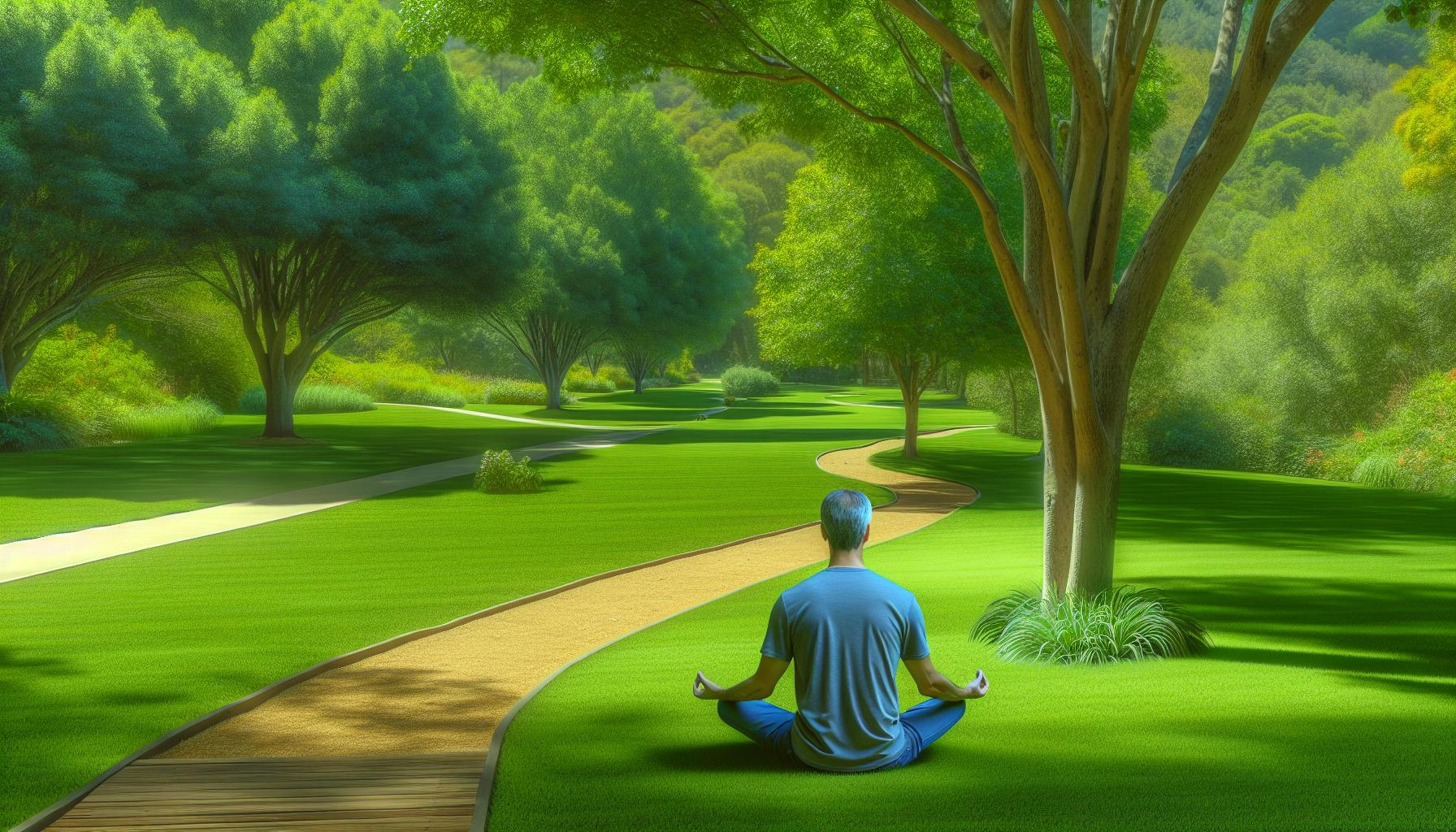Embrace Mindfulness: Daily Life Tips from ‘Wherever You Go, There You Are’
Imagine settling into your coziest armchair with a cup of warm tea, ready to peel back the layers of a book that promises a journey into tranquility. That’s exactly what Jon Kabat-Zinn offers in “Wherever You Go, There You Are.” This book isn’t just about meditation; it’s an invitation to weave mindfulness into the fabric of everyday life. As I turned its pages, I found each chapter sprinkled with insights that felt like discovering hidden gems in a well-trodden path—familiar yet fresh and enlightening.
Kabat-Zinn, with his gentle guidance, makes the concept of living in the moment not only accessible but also irresistibly appealing. He teaches us how to pause amidst our bustling lives and appreciate the here and now. It’s a technique that promises to enrich our days, making ordinary moments extraordinary. As we dive deeper into his teachings, we uncover the beauty of a mindful existence, where every breath and every step can be a source of joy.
Overview of “Wherever You Go, There You Are by Jon Kabat-Zinn: Mindfulness Meditation in Everyday Life”
Launching right into it, if you’re ready to dive deep into the refreshing pools of mindfulness, Jon Kabat-Zinn’s “Wherever You Go, There You Are” is your personal invite to the mindfulness party. This book isn’t just about sitting still with your eyes closed; it’s about inviting peace and awareness into your life’s bustling chaos.
The Author: Jon Kabat-Zinn
Let me introduce you to Jon Kabat-Zinn, a champion of mindfulness who’s essentially the cool uncle of meditation. His work? Ground-breaking. With a PhD in molecular biology from MIT, Jon didn’t just stay in the labs. Instead, he founded the Stress Reduction Clinic and the Center for Mindfulness in Medicine, Health Care, and Society at the University of Massachusetts Medical School. Imagine a scientist with the heart of a Zen master; that’s Jon. Through his books and teachings, he’s made mindfulness accessible for everyone, proving you don’t need to be a monk to master your mind.
Key Themes and Concepts
Into the heart of the matter, the themes in this book are like hidden treasures in your backyard. Kabat-Zinn brings mindfulness down to earth, discussing how to be present whether you’re washing dishes or walking the dog. He demystifies meditation, making it clear that it’s not about blanking out your mind but about embracing the full experience of living. His concept of “non-doing” is a game-changer: It’s about being present without striving, which, if you’re like me, can feel like a radical act in our hyper-productive society. Every page gently nudges you to slow down and actually taste life, one mindful moment at a time.
The Importance of Mindfulness

Mindfulness isn’t just a fancy buzzword; it’s a transformative approach to living. As Jon Kabat-Zinn introduces in “Wherever You Go, There You Are,” mindfulness isn’t about adding something new to your day but transforming how you already live.
Benefits of Mindfulness Meditation
Engaging in mindfulness meditation comes with a truckload of perks, and I’m not just talking about feeling zen. Studies have shown that regular mindfulness practice boosts your mood, reduces stress levels, and enhances overall brain function. For instance, participants in a study from the University of Massachusetts reported a significant decrease in anxiety after an 8-week mindfulness course. Plus, if you’re trying to keep your blood pressure in check, mindfulness might be your new best friend. It gives your heart a break and your mind a playground!
Mindfulness in Daily Activities
Incorporating mindfulness into daily activities turns the mundane into the meaningful. Imagine finding a slice of peace while stuck in traffic or feeling a wave of calm washing dishes. Kabat-Zinn champions this approach by highlighting the magic in the everyday. It’s about being present—really present—in what you’re doing. By focusing on the sensations of walking your dog or feeling the water against your skin as you wash up, you unlock a level of awareness that turns these simple acts into moments of mindfulness. This practice doesn’t just make life more enjoyable; it offers a refreshing perspective amid our chaotic lives.
Techniques and Practices

Diving into “Wherever You Go, There You Are,” by Jon Kabat-Zinn, teaches us the beauty of incorporating mindfulness into the bustle of daily life. It’s about finding calm in the chaos, one mindful step at a time.
Sitting Meditation
Beginning with sitting meditation, let me break it down for you: Imagine you’re sitting down to enjoy your favorite cup of coffee, only this time you’re paying attention to every tiny detail—the warmth of the cup in your hands, the aroma of the coffee, the cozy vibe around you. That’s what sitting meditation is all about! It’s about being present with your experience, minus any critiques or judgment calls from the busiest parts of your mind.
Kabat-Zinn simplifies this practice using straightforward, focused instructions. Plant yourself firmly on a chair or a cushion—doesn’t matter if it’s fancy, comfort is key. Align your spine like it’s the proudest tower in the city, keep that head up, and relax your shoulders. Now, close your eyes gently, as if you’re about to drift into a peaceful nap, and turn your attention inward. The goal here isn’t to block thoughts, but rather to observe them without getting hooked—just let them float by like clouds on a breezy day. Daily practice ranges from as little as five minutes to as long as an hour, but each session enriches your mind’s capacity to stay in the now, reduces stress, and yes, even boosts your mood.
Walking Meditation
Let’s get moving—with walking meditation! Say goodbye to the autopilot mode we’re all guilty of when mindlessly shuffling from point A to B. Walking meditation transforms your everyday stroll into a session of active awareness. You’ll start by focusing on the feel of your feet touching the ground, the rhythm of your stride, and the sensation of moving through space.
Here’s how it goes: Find a quiet path, could be a hallway, a park, or just a secluded section of your backyard. Start walking slower than usual, paying attention to the lifting and placing of each foot, the sway of your arms, and the gentle inhale and exhale of your breath. This practice isn’t just a workout for the body but also a soothing massage for the mind—it’s about finding a rhythm in the movement and syncing your mind to the present moment.
Regularly integrating walking meditation into your routine can help sharpen your concentration and give you a fresh perspective on the day-to-day environments, making even the daily dog walk or trip to the mailbox a profound experience of mindfulness.
By mastering these techniques, you’re not just passing time—you’re enriching every moment of your life with clarity and intention. Why wait to turn ordinary into extraordinary?
Implementation of Mindfulness in Everyday Life

Jon Kabat-Zinn’s “Wherever You Go, There You Are” shows us that there’s magic in the mundane—if you’re paying attention. Let’s dive into how you can transform everyday moments with mindfulness.
Challenges and Solutions
Integrating mindfulness might seem daunting at first, with the chaos of daily life often drowning out our best intentions. Here’s how to tackle a few common challenges:
- Finding Time: Think you’re too busy? Incorporate mindfulness into routine activities. Brushing your teeth? Focus on the taste of the toothpaste and the sensation of the brush. Every minute counts.
- Staying Consistent: Set simple reminders on your phone or stick notes in places you’ll often see. A note on your fridge saying, “Are you really here?” might just do the trick.
- Doubting the Process: It’s normal to question if you’re “doing it right.” Remember, mindfulness is about observation without judgment. If you’re noticing your thoughts, you’re on the right track.
It’s not about perfecting mindfulness, but practicing it. Each attempt, even if fleeting, is a step toward a more present you.
Real Life Examples from the Book
Kabat-Zinn fills his book with relatable scenarios that bring mindfulness off the cushion and into the chaos of everyday life:
- Walking the Dog: Instead of planning your day, notice the sensation of the leash in your hand, the smells in the air, the rhythm of your steps.
- Waiting in Line: Turn a dull moment into an opportunity. Feel your feet on the floor, listen to the surrounding sounds. It’s not about wasting time; it’s about experiencing it.
- Eating Dinner: Slow down. Taste each bite. Engage your senses. How often do we eat in front of the TV and miss the experience?
By using these simple moments as opportunities for mindfulness, we transform them into enriching experiences that ground us in the now.
Conclusion
Reflecting on Jon Kabat-Zinn’s insights has truly opened my eyes to the beauty of mindfulness in transforming the simplest moments into profound experiences. It’s clear that adopting a mindful approach isn’t just beneficial—it’s essential for living a more present and fulfilled life. By integrating mindfulness into our daily routines we can uncover a deeper appreciation for the here and now which is often lost in our fast-paced world. I’m inspired to continue exploring these practices and I hope you are too. Let’s embrace the journey of mindfulness together enriching our lives one moment at a time.

